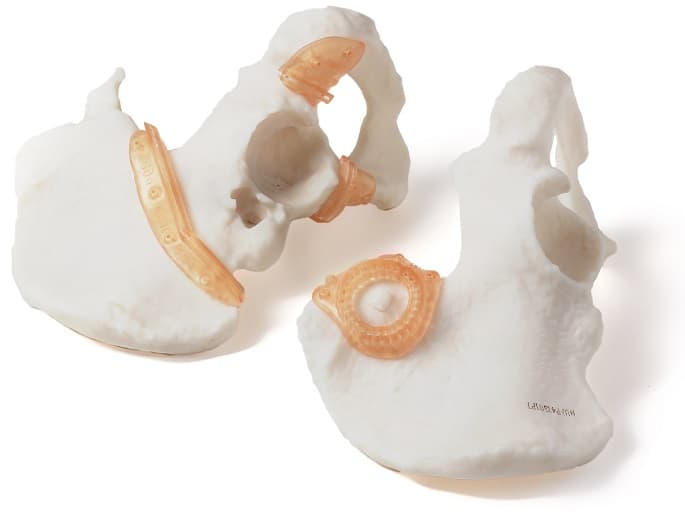3D LifePrints‘ Cranio-Maxillofacial surgical planning product, EmbedMed, has received FDA 510(k) clearance. An ISO 13485-certified cloud tool, EmbedMed gives clinicians access to the entire workflow needed to convert DICOM or other scan files into patient-specific implants and surgical guides, as well as to visualize models or discuss procedures with patients and colleagues.
“It is our aim for surgeons across the US to have direct access to Personalized Surgical planning and patient-specific devices. EmbedMed works at scale; whether you are a hospital looking to set-up a Point of Care 3D facility or a surgeon that wants personalized devices for a complex case – our highly qualified bio-medical engineers are here to help,” said Henry Pinchbeck, LifePrints CEO.
3D Printing in Hospitals
Typically, there are a variety of ways for healthcare facilities to take advantage of 3D printing. A hospital can choose to start an in-house 3D print lab, hire an engineer, and make prints in house. This may be cheaper in the long-run, but will take time and cash to get things set up.
Alternatively, a facility could have an engineer order parts from a service bureau, which will result in lower startup costs ,but higher costs and longer wait times per model. However, these printed objects could be made from a potentially wider array of technologies, with a hospital opting for a full-color PolyJet model one time, a cheaper material extrusion piece the next time, or a more detailed, sintered item the time after that.
3D LifePrints gives hospitals another way. Rather than invest in equipment or maintain any engineering capacity on staff, physicians can upload patient scan data to the cloud and EmbedMed takes care of the rest. This could potentially be very easy to adopt and cost efficient. It’s also quite a different approach compared to other medical additive manufacturing software developers. Others sell the software or provide users access on a monthly bases. 3D LifePrints, however, establishes local print centers and offers service locally to nearby hospitals. It then expands to new geographic areas. Beginning in the UK, the firm has since grown globally, most recently opening a center at the Texas Medical Centre in Houston.
“This clearance is the first step in executing 3D LifePrints’ strategy to bring Personalized Surgery to the US. Our facility at the Texas Medical Center, which enables our engagement with hospitals such as Houston Methodist and MD Anderson, will act as the blue-print for a nationwide roll out,” said Scott Parazynski, 3D LifePrints US Strategy Director.
3D LifePrints Developments
LifePrints is additionally developing machine learning capabilities for its software. It’s easy to see how investments in automation could really boost the firm´s bottom line. Customer service, production, and handling could also be outsourced to countries with lower overhead. Meanwhile, 3D LifePrints could also invest in automation, post processing and handling software to make its parts better and cheaper. 3D
LifePrints aims to expand its operations to New York and then Orange County. This geography-per-geography growth strategy can also be potentially lucrative, allowing the company to fill up capacity and operate locally in a very efficient way. It’s also easy to see how 3D LifePrints could cost efficiently outsource its printing capacity or adopt the latest technology.
LifePrints’ go-to-market is potentially very disruptive. To me, the two paths that make sense in 3D printing surgical guides for hospitals are to either go in light or heavy. Either the hospital invests nothing and outsources everything, to not buy into something difficult that will be commonplace soon. Going in heavy would be to have a team of engineers and medical technologists, as well as several 3D printing technologies in house. On that path, the hospital can really win through 3D printing in the long run, enabling lower costs and improved service via 3D printing in everything from braces to surgical devices. If a facility does’t pursue that strategy, it might make the most sense to go in light and call 3D LifePrints.
Subscribe to Our Email Newsletter
Stay up-to-date on all the latest news from the 3D printing industry and receive information and offers from third party vendors.
You May Also Like
US Army Corps of Engineers Taps Lincoln Electric & Eaton for Largest 3D Printed US Civil Works Part
The Soo Locks sit on the US-Canadian border, enabling maritime travel between Lake Superior and Lake Huron, from which ships can reach the rest of the Great Lakes. Crafts carrying...
Construction 3D Printing CEO Reflects on Being Female in Construction
Natalie Wadley, CEO of ChangeMaker3D, could hear the words of her daughter sitting next to her resounding in her head. “Mum, MUM, you’ve won!” Wadley had just won the prestigious...
Blue Laser-powered M600 3D Printer Launched by Meltio
Founded in 2019 as a joint venture between Additec and Sicnova, metal 3D printer OEM Meltio develops and manufactures high-performance and easy-to-use metal 3D printing solutions that use its patented wire-laser metal...
3D Printed Storage Tanks Cut Material Costs by 25%
In a previous article, “Concrete Dreams: Let’s Print Money, Not Houses,” we discussed how the spotlight on 3D printing homes might be misplaced. Bollards, pedestrian bridges, and concrete tanks could...
































